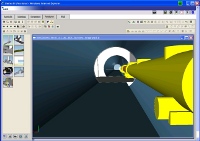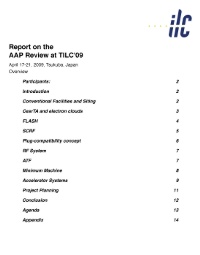 |
 |
|||||||||||||
|
|||||||||||||
|
|||||||||||||
|
A few weeks after the first big Accelerator Advisory Panel (AAP) review at the TILC09 meeting in Tsukuba, Japan, the panel has published its review results (see also the two most recent Director’s Corners on this topic). After two months of preparation, an intense week of presentations and another few weeks of writing up the results, the 13 members – ten ILC researchers and three from outside the linear collider world – presented a set of recommendations that intend to lead the ILC's most important areas of research and development to successful completion by the end of the Technical Design Phase (TDP) in late 2012. “In simple terms: there should be no show stopper for rapid start of construction should the project be approved,” says the preparatory document that all technical area group leaders received well before TILC09. It's what the AAP is all about, after all: making sure that the collider is in theory ready to be built at the end of the TDP, highlighting potential problems or hold-ups to the Director and his management team. The fact that the majority of the reviewers comes from within the project means that it can go into much deeper technical detail than, for example, the more general Project Advisory Committee PAC which reports to the ILC Steering Committee rather than the ILC Director. “The members injected quite a range of opinions, such as the wisdom of former lab directors and project managers familiar with large-scale projects on the one hand and world class experts on the e-cloud business on the other hand. This input is difficult to distill in a single report,” says DESY's Eckhard Elsen, co-chair of the AAP alongside Bill Willis. Nevertheless, AAP also looked at what one would expect to be a PAC focus: the project management. The other main areas were civil facilities and siting, electron cloud, superconducting RF and test facilities. So, what is the advice? Apart from the three examples given by Barry Barish in his Corner this week, the recommendations include consistency and transparency, more beam time for accelerator studies, more simulations, strong links between labs and industry for cavities, competition-driven plug-compatibility trials and a task force for the current baseline re-evaluation studies. They also touch upon governance: “The AAP suggests asking the International Linear Collider Steering Committee (ILCSC) to consider displaying and arbitrating the use of laboratory resources more formally. Proper orchestration of the in-kind contributions is mandatory to advance the likelihood of implementation of the ILC,” their report says. They also believe that the cavity programme at KEK has science goals that do not match the project expectations now that it has had a change of focus onto plug-compatibility and therefore recommend that they should be adapted.
The design and integration studies that currently go by the misleading name of 'minimum machine' were a big topic in the discussions at TILC. One of the AAP's top recommendations is not to jeopardise the scope of the ILC: “The cost of ameliorating any degradations should be assessed to allow informed decisions on which aspects of the MM design to include in the new baseline,” the report says. “The redesign should only be considered for those components and aspects where the benefits are high. During the transition time the RDR solution must be preserved to maintain readiness for construction of the ILC.” They weren't short with praise, either as they commented on the Accelerator Test Facilities ATF and ATF2 at KEK that: “the AAP commends the ATF collaboration for the sequence of successful experiments that have been carried out and led to an impressive record of successful publications. The flexibility of the ATF to react to experimental proposals has been impressive. The AAP applauds the strong and well-organized effort of the collaboration to commission the ATF2 beam line.” Or on the recent 3-D modelling tests for the conventional facilities and siting group: “The AAP is impressed by the progress. The tools are an important aid in understanding critical aspects of a chosen layout, where the benefits from the resource-intensive implementation efforts may be justified.” The teams preparing for the review addressed questions from the AAP and key questions as well. The questions ranged from the overall context of the R&D work in the context of the ILC to experimental input and recent research results to a risk assessment, operation margins and alternatives. At TILC, a typical review day saw some ten presentations with tough question-and-answer times with a couple of internal review sessions as well. The work continued over lunch and into the evening. The next one – to be held in Oxford in early January of next year – will follow a similar scheme. “We considered this an experiment – explore and adapt until we have an answer,” says Elsen. -- Barbara Warmbein |
|||||||||||||
| © International Linear Collider |

